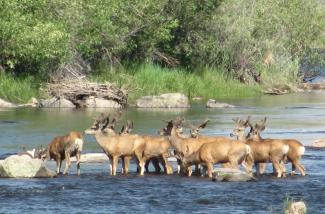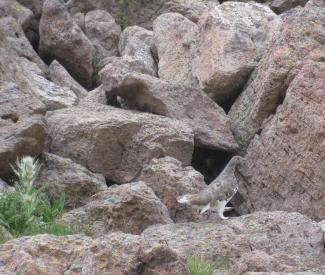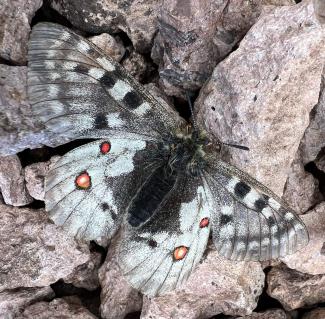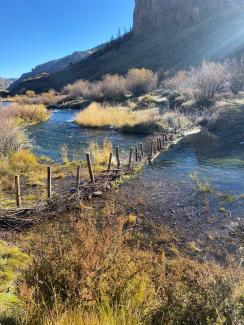Nature and Science
The Rio Grande National Forest is home to many animals. Birds like the golden eagle, and red-tailed hawk soar above the forest. Pika and marmots live high in the mountains among the rocks and elk and deer live throughout the forested areas and open meadows. The forest often hosts spectacular wildflower displays each summer and so many pollinators and other insects also call the forest home.
Read more below to learn about some of the species of fish and wildlife living on the National Forest.
Be a Biologist
You can get involved and help the forest biologists learn more about the fish and wildlife of the area by participating in citizen science projects. Using the iNaturalist website or app you can any signs or sightings of wildlife. Signs include the sound the animal makes, a track, rub or chew marks on a tree, or scat. There are some species the forest biologists are especially interested in. Learn more by visiting the citizen science page or checking out the Forest's Plant and Wildlife Observations brochure.

Respecting Wildlife
It is important to respect wildlife while out on the forest this means not feeding wildlife and storing your food, trash, and other scented items properly so animals like bears or squirrels can not get into it. Keeping your distance from wildlife is also important. You can use the “rule of thumb” to help make sure you are giving wildlife space. Hold your arm straight out and give a thumbs up. Make sure your thumb can cover the entire animal. This is a good way to help you judge distance, and in general you want to stay further away from larger animals!
Species on the Forest

Golden Mantled Ground Squirrels are a common sight on the forest.
Photo Credit: Rio Grande National ForestGround Squirrels
There are many little critters you may see while visiting the Forest. Golden mantled ground squirrels, Colorado chipmunks, and least chipmunks frequent campsites. Golden mantled ground squirrels can be differentiated from the chipmunks because they are a little bigger and do not have stripes on their face. Chipmunks have stripes on their body and their face. Remember, do not feed wildlife as human food can make them sick and wildlife may carry diseases.
Gunnison's prairie dog is a type of ground squirrel that also lives on the forest. The Gunnison's prairie dog is a species of concern on the forest and was petitioned to be added to the endangered or threatened species list however it was not added. Populations are being monitored.
Ungulates
The Forest is also home to many larger mammals, including five species of ungulates, (hoofed animals). The ungulates of the forest are often referred to as big game. Be careful when driving on roads in and around the forest as you will likely see some of these species along the roadway. Deer and elk roam across the Forest from high elevations in the summer to lower areas in winter. Not all deer and elk migrate up and down in elevation with the changes of the season, but many herds do. Elk are bigger than deer and have a white rump and a more bearded neck. Mule deer are the species of deer most common across the forest.

Bighorn sheep prefer steeper, rockier terrain. They are great mountain climbers. Bighorn sheep rams (males) grow large curly horns and the ewes (females) have smaller horns that don’t curl. There are a few populations of bighorn sheep across the forest Moose also live on the forest, and they prefer willowed and wetter areas. They are the largest member of the deer family. Moose are not native to Colorado, they were introduced to Colorado in 1978 with individuals from Utah and Wyoming. Later they were introduced to the Rio Grande National Forest area in 1991-1993.
The Pronghorn is the fastest land mammal in North America and can run at speeds of 55 mph. They prefer to live in the lower elevations and open areas where they can use their speed. They are often called antelope and while they resemble antelope, they are not closely related to the antelope that live in Africa. The pronghorn’s closest living relative is actually a giraffe!
Horns or Antlers?
Antlers are made of bone and grown right from the skull. Members of the deer family have antlers and are usually found on the males. Antlers are shed annually and are re grown each year. When antlers are growing they are covered in ‘velvet’ a tin, soft layer of skin and blood vessels. This ‘velvet’ is then shed and later the antlers. Antlers grow in a branching pattern where horns don’t.
Horns are found on animals like bighorn sheep, bison, cows, and goats. The horn is made of an interior portion that is bone and an outer sheath that is made of keratin, the same material as our fingernails. Horns are often found on both males and females although the horns are usually smaller on females like in the case of bighorn sheep. Horns are never shed and grow continually throughout the animal’s life.
Pronghorn are unique in that they have a horn that has core of bone and a sheath of keratin. The structure of a pronghorn’s horn is like a horn, but the other characteristics are much more similar to antlers, an interesting mix! The keratin sheath is branched, and this sheath is shed each year, unlike horns and more similar to antlers.
Lynx: Return of the Snow Cats

The Rio Grande National Forest played a key role in Lynx reintroduction.
Photo Credit: Rio Grande National ForestLynx are a wild cat that loves to live in cold, snowy areas like our mountains here in Colorado. They have big paws to help them walk on top of snow, like snowshoes! They are bigger than the more common bobcat and have ear tufts and a tail with a black tip rather than spotted like the bobcat.
Historically Lynx were trapped for fur and the lynx population in Colorado dropped rapidly through the late 1800s and early 1900s. Colorado state listed lynx as an endangered species in 1973 and the last known lynx in Colorado was illegally trapped in 1974. Lynx also faced habitat fragmentation which further impacted their population numbers.
Colorado Parks and Wildlife (CPW) worked to bring back lynx to the state through a reintroduction program. In 1999 the first lynx were brought from Canada and Alaska to the San Juan Mountains. Over several years over 200 individuals were brought to Colorado to create a self-sustaining population. Today lynx are rare, but their reintroduction was a success. Martha and lynx photo

A white tailed Ptarmigan blends in with it's surroundings.
Photo Credit: Rio Grande National ForestAt night, listen for owls. At lower elevations in ponderosa or Douglas fir stands you may hear a flammulated owl who has a very low hoot for a tiny owl. Flammulated owls eat primary insects, especially crickets, moths, and beetles. At higher elevations in spruce-fir forests you may hear a boreal owl. Like most owls, the boreal owl hits rodents and other small mammals primarily at night.

Osprey an commonly found near lakes and rivers.
Photo Credit: Rio Grande National ForestAt high elevations above the trees, you might spot a well camouflaged white-tailed ptarmigan. These birds change color to camouflage with the seasons, turning white in winter and greyish brown in the summer.
Olive sided fly catchers like forests with many open areas that make hunting insects easier. Often, they will inhabit previously burned areas. You may be more likely to hear this bird as it has a recognizable whistling call that sounds much like quick, three beers!
Common birds you may see around camp include juncos, hermit thrushes, and several species of corvids (crow family), including Canada jays, Steller's jays, and Clark’s nutcrackers.
You can report bird sightings on the iNatualst app. The Merlin Bird ID app is a great tool to help identify and track your sightings too.

A Boreal Toad with a thin white stripe down its back blends in with his muddy surroundings.
Amphibians inhabit the wetter meadows, ponds, and forests. Chorus frogs and barred tiger salamanders are found throughout the Forest. The boreal toad is rare and listed as an endangered species in Colorado. Many partners including CPW and the USFS are working to monitor and improve habitat for boreal toads on the Forest and across the state.

Our biologists are monitoring two rare insects on the Forest. At high elevations, the white veined arctic butterfly is a rare find and across the Forest, western bumblebee is also of interest. There are many different bee species, all of which are important pollinators but are very difficult to tell apart!

The western Bumble Bee.

The Rio Grande Cutthroat trout and their distinctive red coloring.
The Rio Grande cutthroat trout is one of many subspecies of cutthroat throughout the West but is the only native trout found on the Forest. The trout lives the furthest south of any cutthroat trout species. The Rio Grande cutthroat trout live in the Rio Grande and Pecos River drainages. Like many trout, they like to live in cold water streams and lakes.

A beaver dam analogue simulates a natural dam.
The Rio Grande National Forest is working with Colorado Parks and Wildlife to improve habitat conditions for the native trout. This includes reducing populations of non-native species that compete for food and space and creating better habitats with the help of beavers! Learn more about the trout in the video below.



